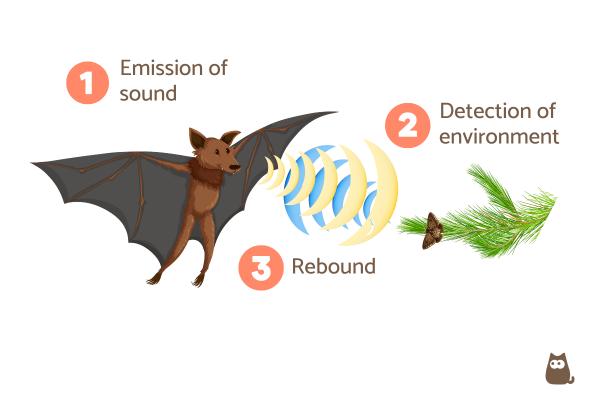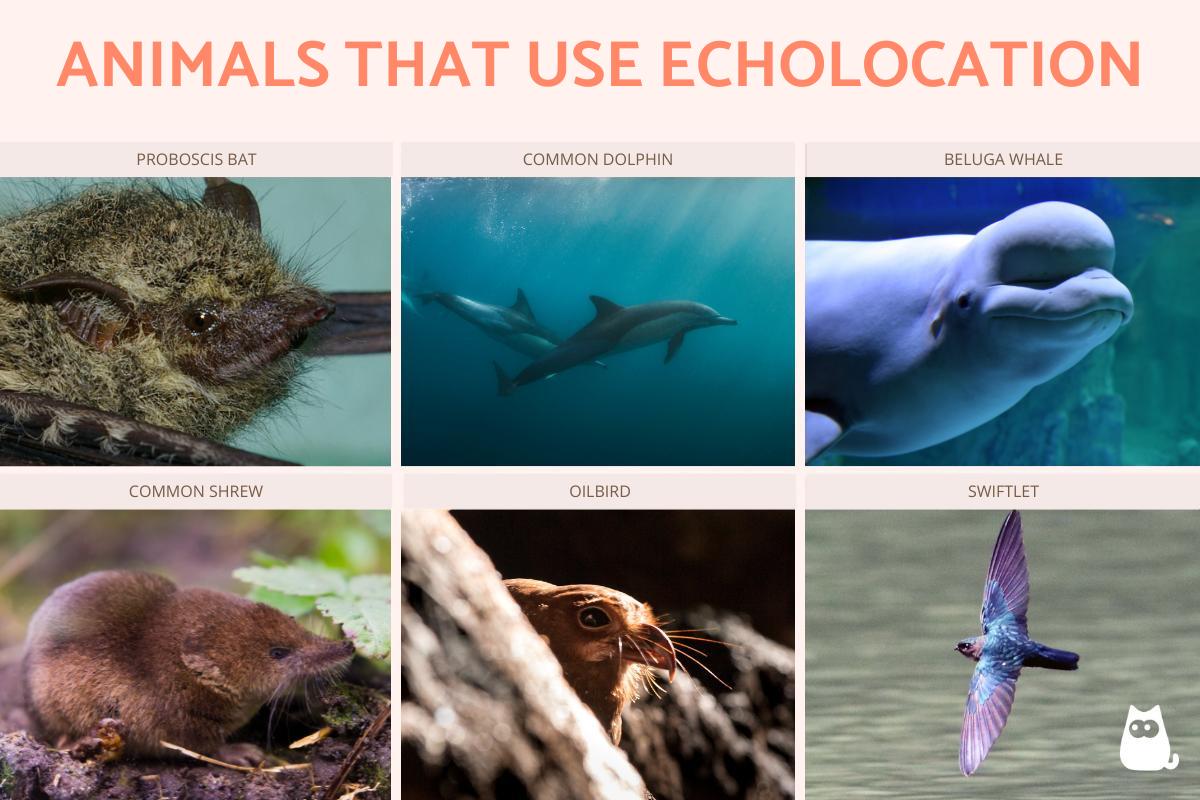Animals That Use Echolocation - List of Examples


Echolocation is an evolutionary adaptation which has afforded certain animals an advantage in understanding their environment. Also known as bio sonar, this ability allows animals to locate themselves and others spatially. This is a very useful trait for various reasons. It allows predators to hunt better and prey animals to evade predation. It also allows members of the same species to locate each other for various purposes such as mating and migration.
At AnimalWised, we provide our animals that use echolocation list so you can know what species have this ability. We also provide examples of how these animals use bio sonar with photos and diagrams for illustration.
What is echolocation in animals?
Echolocation is defined as a physiological process used by some animals whereby calls are sent out to create an echo which the animal interprets to determine their location. These calls are soundwaves which bounce off various elements of their environment. In doing so, they not only determine location, but can provide other data from their environment. This is information which cannot be perceived in other ways such as with vision.
The ability of animals to use echolocation was confirmed in the 1940s. The hypothesis was considered long before after studies of behavior suggested bats could use sound to determine location. It wasn't until analysis of various anatomical parts that this ability was determined to be possible.
Many animals can emit various sounds as part of their communication process, interpreting the echoes that are formed. Despite having a similar ability, echolocation is a highly specialized acoustic adaptation used in a particular way by different species. Millions of years of evolutionary adaptation has resulted in certain species refining and improving this ability. This includes the ability to emit ultrasonic pulses that cannot be heard by humans or other animals.
What is echolocation used for?
The primary purpose of echolocation is for the animals to orient themselves in a given environment. This is useful for many reasons. Certain nocturnal animals do not have the benefit of light to navigate, so they use echolocation to guide themselves. Another issue might be marine animals that live at very low depths or have no visibility due to silt. Similarly, some terrestrial animals live in dark caves or similar low-light environments.
In addition to avoiding obstacles, echolocation is essential for obtaining food. The species that rely on this system emit their sounds to obtain information about possible prey that they later easily capture.
Echolocation can also help in social interactions. Although they have many different ways of communicating information between individuals, it helps them to identify other animals. This can help them if one of their number is lost or if there is a potential predator in their vicinity. Research is suggesting that the usage of echolocation for communicating information is likely more complex than once believed[1].
How does echolocation work?
Echolocation is a complex process that begins when the animal emits pulses or sounds in short bursts. They use very specific frequencies that are measured on a scale of around 1,000 Hz to around 200,000 Hz, depending on the species. In this way, some animals emit extremely low frequencies, while others are considerably much higher.
After emitting the waves, they collide against the different elements of their environment and return to the place of origin. Specific adapted structures of the animal allow them to capture them and obtain very precise information. They can identify potential prey, as well as safeguard the rest of their group.
Some animals can also use their own echolocation against others in a process known as echolocation jamming[2]. While echolocation allows some animals to orientate themselves, jamming can allow them to disorientate others. Echolocation is most commonly used in gregarious animals, i.e. animals that live in groups.
Organs and structures that allow echolocation
As we have already stated, it is the physical adaptations which have allowed certain animals to echolocate. We explain some of these anatomical structures which allow echolocation:
- Cetaceans: including whales and dolphins, these animals produce high-frequency clicks which they direct in the direction of a place of interest. These waves are produced when the air passes through the nasal structures close to the blowhole. They are then reflected in the skull, all of which is modulated by a fatty organ, typical of these mammals. This organ is called the ‘melon’. The animal receives the echoes and perceives them thanks to other fatty structures located in the jaw. They are then processed in the middle ear. Learn more about the different types of cetaceans.
- Bats: they usually emit the sound in the larynx and it comes out through the mouth. A few species can do it through the nose. Afterwards, the returned echo is processed by a small structure called the ‘tragus’ which is located in the outer ear and allows the information to be interpreted.
- Birds: echolocation is perhaps less complex than in other animals. The sound is audible to humans. In this case, it comes out through the mouth and the returning echo is then processed by the ears. Despite being less complex, it also allows them to echolocate food or objects in the environment due to the very special way in which they process the feedback information.

Animals that use echolocation examples
We ave already explained some of the animals that use echolocation by explaining what structures they use. We now share some of the specific species of animals that use echolocation, as well as photos below of some key examples.
Echolocation is present in the following groups:
- Many bat species: specifically all those commonly grouped as microbats (the order Microchiroptera) and one genus of megabat known as Rousettus. Some species that we can mention as examples of bats with echolocation are include the white-winged dog-like bat (Peropteryx leucoptera), proboscis bat (Rhynchonycteris naso) and spectral bat (Vampyrum spectrum). Discover more bat species with our guide to flying mammals.
- Toothed whales: these are cetaceans of the parvorder Odontoceti. the cetacean group, types of marine mammals. They include various types of porpoises, dolphins and any whales which have teeth such as beluga whales. As we said, all cetaceans carry out echolocation.
- Shrews: not all, but some species of shrew are able to echolocate. They include those belonging to the family Soricidae. Some examples of these animals with echolocation are the Kashmiri pygmy shrew (Sorex planiceps), Tibetan shrew (Sorex thibetanus), common shrew (Sorex araneus) and long-tailed shrew (Sorex dispar).
- Oilbird: native to South America and some areas of Central America where it is known as the guácharo (Steatornis caripensis). These birds live in caves where they take refuge during the day and come out at night, which is when they are active.
- Some swiftlets: some members of the Collocaliini tribe, including cave swiftlets (Collocalia linchi).
Although we can hear some of their sounds, the human ear cannot capture the echolocation waves emitted by many cetaceans and bats. However, the human ear does perceive the sound of birds.
In bats and some of the toothed whales there is a gene that is related to this echolocation system, which makes it easier for these two groups to receive the waves more sensitively when they return. The most striking aspect of this is the presence of a practically identical gene in totally different animal species. This indicates the occurrence of a process known as convergent evolution, i.e. the same trait develops independently in two different groups of the same species.

If you want to read similar articles to Animals That Use Echolocation - List of Examples, we recommend you visit our Facts about the animal kingdom category.
1. Jones G. (2008). Sensory ecology: echolocation calls are used for communication. Current biology: CB, 18(1), R34–R35.
https://doi.org/10.1016/j.cub.2007.10.056
2. Kloepper, L. N., & Branstetter, B. K. (2019). The effect of jamming stimuli on the echolocation behavior of the bottlenose dolphin, Tursiops truncatus. The Journal of the Acoustical Society of America, 145(3), 1341. https://doi.org/10.1121/1.5093636
- Britannica, T. Editors of Encyclopaedia. (2023). Dolphin. Encyclopedia Britannica. https://www.britannica.com/animal/dolphin-mammal
- Whitlow, W. (2009). Echolocation. Retrieved from: https://www.sciencedirect.com/topics/agricultural-and-biological-sciences/echolocation







